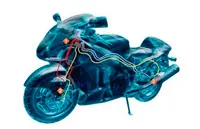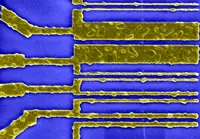Electronics News
Archive : 7 October 2015 год
 Freescale has introduced the SB0400 and SB0401, said to be the industry’s first ICs specifically engineered for ABS systems on motorcycles and scooters. By incorporating these 7 x 7mm devices into their designs, Freescale says that manufacturers of ECUs no longer need to rely on larger ABS ICs developed for automobiles.
Freescale has introduced the SB0400 and SB0401, said to be the industry’s first ICs specifically engineered for ABS systems on motorcycles and scooters. By incorporating these 7 x 7mm devices into their designs, Freescale says that manufacturers of ECUs no longer need to rely on larger ABS ICs developed for automobiles.
Freescale’s two-wheel SB0400 IC is designed for use with motorcycles, while the single-wheel SB0401 IC is intended for scooters and lighter motorcycles. Both products are leadless and, due to a low RDS(on), neither require heat sinks, saving system cost and space. Featuring Freescale’s SMARTMOS analogue-mixed signal technology, the devices integrate an ABS system’s wheel speed sensor interface, valve drivers, motor pump driver, safety switch and safety state machine into what Freescale claim is the smallest package size available on the market for motorcycle or scooter designs.
Jonathan Godillion, application engineer at Freescale, said: “Freescale has 20 years of experience making ABS systems for four-wheeled vehicles. The SB0400 and SB0401 are based on our automotive system; the big challenge was to reduce the size of the motorcycle system while keeping the same features.”
The introduction of these products coincides with the upcoming implementation of European Commission legislation making it mandatory for manufacturers to fit all new motorcycles with engine sizes above 125cc with ABS from 1 January 2016. This is in line with a rise in motorcycle manufacture in the past few years to almost 100 million units, led by growth in India and China, along with continuing high numbers of accidents involving two-wheeled vehicles. Global sales of motorcycles and scooters are set to increase by 5.9% to reach 132 million units by 2018. By this time ABS will be mandatory in two-wheel vehicles in the EU, Japan and India while in 2019 ABS will be mandatory in 50cc scooters as well.
“Motorcycle ABS helps the rider maintain stability during braking,” added Godillion. “The average stopping distance of a motorbike travelling at 100kmph fitted with ABS over one that doesn’t is 18% less, which equates to 9m, and this distance increases the slower the bike is being driven.”
Both devices are pin-to-pin compatible which reduces system design efforts. Integrated hardware safety functions for protection/diagnostics include over-voltage, under voltage, over temperature, short and open load detection.
Patrick Morgan, general manager for ADAS Radar and Safety Products for Freescale, said: “As braking requirements for two-wheel vehicles grow increasingly stringent, Freescale is responding with designs that enhance driver safety while helping manufacturers of electronic motor control systems meet critical safety requirements, while saving cost, space and weight.”
Author
Tom Austin-Morgan
Source: www.newelectronics.co.uk
 Wind River has introduced the latest version of Wind River Linux. Wind River Linux 8 is said to bring together the flexibility and interoperability of open source along with improved user experience and scalability for addressing the opportunities and challenges of IoT.
Wind River has introduced the latest version of Wind River Linux. Wind River Linux 8 is said to bring together the flexibility and interoperability of open source along with improved user experience and scalability for addressing the opportunities and challenges of IoT.
The latest version of Wind River Linux is claimed to deliver a reduction in set-up and installation time. It uses the latest kernel and toolchain from the Yocto Project 2.0 release, Linux kernel 4.1, and GNU toolchain 5.2. Wind River Linux 8 also features hardware support for Intel, ARM, MIPS, and PowerPC architecture.
Wind River Linux 8 will serve as the baseline for existing technology profiles, including Carrier Grade Profile for Wind River Linux, Security Profile for Wind River Linux, and the newly enhanced Open Virtualisation profile for building and deploying a cloud operating system. The new features enable cloud services and high-performance computing capabilities to integrate a compute node to a number of frameworks or infrastructure providers.
“Wind River Linux allows customers to extract vast amounts of business intelligence and value from their data, and supports devices of all sizes, architectures, and industries-from general purpose and high-performing real-time devices to carrier grade, virtualisation, and highly secure military applications,” said Dinyar Dastoor, vice president and general manager of operating system platforms at Wind River. “With the latest version of Wind River Linux and our updated Open Virtualisation profile, we are delivering a versatile and robust Linux offering to the market that is ideally suited for the development of IoT devices.”
Pic: Dinyar Dastoor, vice president and general manager of operating system platforms at Wind River
Author
Tom Austin-Morgan
Source: www.newelectronics.co.uk
 Japan has announced that it is to start testing an autonomous taxi service on its public roads in 2016, as the country looks to show off its technology in time for the Olympic Games being held in Tokyo in 2020.
Japan has announced that it is to start testing an autonomous taxi service on its public roads in 2016, as the country looks to show off its technology in time for the Olympic Games being held in Tokyo in 2020.
According to the Nikkei the self-driving taxi service programme will look to have a fleet of driverless taxis up and running in time for the Olympics, and the project is intended to get companies interested in looking at how to commercialise the technology.
The scheme, which was unveiled by the Japanese government and Robot Taxi, a joint venture between the mobile Internet company DeNA and the vehicle technology developer ZMP, will initially serve about 50 residents in the Kanagawa prefecture, shuttling them between their homes and local grocery stores.
The cabs, which will be retrofitted versions of Toyota's Estima hybrid minivan, will drive around two miles and the route will include major city roads. To ensure safety two co-pilots will be present during test drives, in case of an emergency.
While the number of vehicles deployed has yet to be disclosed if the program is a success, Robot Taxi said that it was looking to a fully commercial service running within five years.
Author
Neil Tyler
Source: www.newelectronics.co.uk
 Dialog Semiconductor has released a Bluetooth Smart development kit, which supports Apple HomeKit, to accelerate development of smart home accessories. In a recent report on the connected home, BI Intelligence predicted that the smart home market will grow at an annual rate of 67% between now and 2019, resulting in 1.8 billion accessories being shipped in that year.
Dialog Semiconductor has released a Bluetooth Smart development kit, which supports Apple HomeKit, to accelerate development of smart home accessories. In a recent report on the connected home, BI Intelligence predicted that the smart home market will grow at an annual rate of 67% between now and 2019, resulting in 1.8 billion accessories being shipped in that year.
Based on Dialog’s SmartBond DA14580 SoC, the Bluetooth Smart development kit is designed to help create accessories with fast response times. Initial pairing set up is said to take 4.5s and pair-verify, which occurs whenever an iPhone, iPad or iPod touch issues a command, takes 250ms. The DA14580, which is available in a 2.5 x 2.5mm package, offers a peak current of less than 5mA.
“HomeKit is unifying smart home accessories with a common set of controls, user interface elements and end-to-end encryption which is an important step for the home automation market,” said Sean McGrath, senior vice president and general manager, Connectivity, Automotive & Industrial Business Group at Dialog. “Our kit enables developers to achieve differentiation and a competitive advantage through delivering a superior user experience and accelerating time to market for their smart home accessories.”
The SmartBond development kits feature a power profiler for power-optimised coding and Dialog’s SmartSnippets software development environment, based on Keil µVision tools.
Author
Tom Austin-Morgan
Source: www.newelectronics.co.uk
 A major breakthrough claimed by IBM Research could see carbon nanotubes replacing silicon transistors more quickly than previously expected. According to the scientists, they have shown a new way to shrink transistor contacts without reducing performance of carbon nanotube devices, potentially enabling faster, smaller and more powerful devices.
A major breakthrough claimed by IBM Research could see carbon nanotubes replacing silicon transistors more quickly than previously expected. According to the scientists, they have shown a new way to shrink transistor contacts without reducing performance of carbon nanotube devices, potentially enabling faster, smaller and more powerful devices.
Until now, as nanotube based devices become smaller, increased contact resistance has negated any performance gains. These results could overcome contact resistance challenges all the way to the 1.8nm node – four technology generations away.
“For any advanced transistor technology, the increase in contact resistance due to the decrease in the size of transistors becomes a major performance bottleneck,” said Dario Gil, vice president of Science and Technology. “Our approach is to make the contact from the end of the carbon nanotube, which we show does not degrade device performance. This brings us a step closer to the goal of a carbon nanotube technology within the decade.” IBM has previously shown that carbon nanotube transistors can operate as excellent switches at channel dimensions of less than 10nm.
Until now, decreasing the size of the contacts on a device caused a commensurate drop in performance – a challenge facing both silicon and carbon nanotube transistor technologies. To solve the problem, IBM’s researchers invented a metallurgical process akin to microscopic welding that binds metal atoms chemically to the carbon atoms at the ends of nanotubes. This ‘end-bonded contact scheme’ allows the contacts to be shrunken beyond 10nm without affecting the performance of carbon nanotube devices.
Author
Graham Pitcher
Source: www.newelectronics.co.uk

